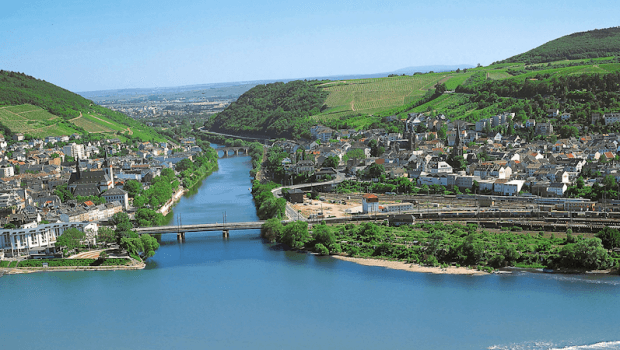
Located in the district of Mainz-Binger within the Rhineland-Palatinate in Germany, Bingen am Rhein is a large town. The original name of this city, derived out of its Celtic routes was Bingium.
The Town has an aura originating out of mystic confluences starting from rivers, then cultures and the legendary environs that are in the locale. The most fascinating part about the town is its location, the historically established trading routes which are present alongside the river. An avid and obsessive traveller does once make a visit here to Bingen.
Here you can enjoy the longest running wine festival and witness the Rhine in Flames along with the Bingen Winzerfest. Load yourself on with some of the most exquisite wines and then move on the groovy celebrations of the Bingen Swingt – all of this and much more, here at Bingen.
Geography
Bingen is situated just about in the south-eastern side of the Rhine knee which is located by the Bingen Forest. The forests begin from the western end of the town. When you travel towards the north you will find the Rheinagau mountain range on the southwestern cornerstone of the river Taunus which is marked by the upstream Niederwald in Rudesheim. It is in-fact here that the river Nahe drains itself in the Rhine Gorge. The town of Bingen also is located on what is called the southern limit of the UNESCO Rhine Gorge World Heritage Site.
The town of Bingen am Rhein is divided into eight parts:
- Bingen City
- Bingen-Bingerbrück
- Bingen-Büdesheim
- Bingen-Dietersheim
- Bingen-Dromersheim
- Bingen-Gaulsheim
- Bingen-Kempten
- Bingen-Sponsheim
The region receives an average annual rainfall of about 564 millimetres, thus making it one of the few regions which receive such low amounts of rainfall in Germany. February is the driest month and the most amount of rainfall is received in the month of June. But in general you will see that the amount of rainfall is actually evenly distributed.
Travel
Transportation facilities are ample and almost all the modes thinkable are available not only for travelling but also for the adventurer in you.
If you desire to take the rail then the main station of the region is called the Bingen (Rhein) Hauptbahnhof. It is situated in the outlying centre of Bingerbrück. From this point onwards you can also take regional trains using the Inter-City and the ICE lines. The Bingen (Rhein) Stadt station lies further 2 kilometres in the east which is also right across the historical harbour crane. This station is specifically there for local transportation. Trains from here also take a stop at the Bingen-Gaulsheim. There is also a great amount of historical significance granted to these stations. For instance, the main railway station was a result of the Prussian border station which was built by the Rhenish Railway Company which is located on the west Rhine Railway. Whereas the other station located in the town at the time belonged to the Hessian Ludwig Railway.
Germany is known for its beautiful road networks. Bingen is located near to the Autobahnen A 60 and A 61. These roads are also linked with the town of Bundesstraße.
River Rhine has also facilitated water way transportation for many a centuries. However, today there is only private mode of transportation here that holds any amount of significance. There also used to be a cargo harbour which has been abandoned and lies vacant and the winter harbour has been converted into a marina.
Köln-Düsseldorfer, Bingen-Rüdesheimer Fahrgastschifffahrt and Rösslerlinie – these areas provide landing stages for tourists. From these posts you can also catch ferries which are big enough to carry your cars and serve as a major link between Bingen and Rüdesheim.
For the sports enthusiasts Bingen provides a gateway to the UNESCO World Heritage Upper Middle Rhine where you can find tracts for cycling and hiking trails. There is also the Hiwwel route which is there at the meeting of Rhine and Nahe Cycling routes located in the triangular formation between Rhein-Nahe at Bingen.
History
The location of the town of Bingen am Rhein, where the two rivers – Rhine and Nahe fuse together, just because of this one reason, there has been many a number of settlements even before the Romans came here. Everything here seems to have begun by a Celtic tribe particularly from the Gaulish line. They were known as the Binge which literally means rift. Then during the time of the 1st century AD came about the Romans whose troops were stationed at Binge to protect the Rhine Valley Road. Thus came about a change in the name of the region to Bingium.
The Romans are also known to have constructed the bridge on the Nahe and also a bridgehead castrum. These constructions were symbolic of the strategic importance of the region to the Romans. In a matter of time there also came about a Roman Mithraic monument. This monument carried a mutilated sculpture which represented the nativity of the Mithras from the rock. Interestingly, it was discovered in Bingen itself and radiocarbon dating has shown that a few of the inscriptions present on the surface dates to AD 236.
Aetherius of Bingen who was a presbyter somewhere between A.D. 335 and 360 founded a Christian community in the region. Aetherus’s tombstone carries evidence of the same and this tombstone can today be witnessed at the Saint Martin’s Basilica.
Furthermore, when the line of Limes Germanicus fell the town and the related region came about in the dominion of a Frankish Royal estate and from there on it moved into the Donation of Verona from Otto II to Archbishop Willigis of Mainz in AD 983. The Bimger Kammerforst or the forest was created under the rule of Otto III and Willigis dictated the construction of a stone bridge or the Drususbrücke on the river Nahe.
The population of Binger was never quite happy with their rulers and therefore strived for independence which resulted in many forms of disputes. The more adverse kind of dispute arose in 1165 between the Archbishop of Mainz and the Emperor. This caused massive amounts of damages and the tension increased massively. During the 13th century, Binger came about to hold the membership of the Rhenish League of Towns. Furthermore, in the mid of this century the Klopp Castel or Burg Klopp also began.
Spirit of gaining independence never really managed to subside in the minds of the population. In 1525 they participated in an uprising which came to be known as the German Peasants’ War. It was like a last desperate attempt for them to overcome the leadership. Not to dismiss their efforts, the revolt did manage to stir a good amount of fear in the minds of the aristocracy. But there was nothing conclusive that was achieved. Failure was rather inevitable because of the intense marshal opposition that the rebels faced at the hands of the aristocrats.
Till about the 18th century Bingen remained largely remained under the administrative control of the Cathedral Chapter of Mainz and like the many other towns present in the valley, Binger too faced many events of destruction by fire and the endless wars.
For a brief period, between 1792 and 1813 Bingen became a part of the département of Mont-Tonnerre or Donnersberg – both of which mean the Thunder Mountain when the French revolutionary troops had occupied the left bank of the Rhine.
The Congress of Vienna was constituted in the year 1816 and as per the diktat of the congress the town was to move into the hands of the Grand Duchy of Hesse-Darmstadt. On the other hand, what is todays outlying centre of Bingerbrück, it went to the region occupied by the Prussians in the Rhine Province. Bingen became a border town till the year 1871. It was after this time that the German Empire was founded. Nearly a hundred years later, om the 22nd of April, 1972 the town of Bingen was formed by the amalgamation of the municipalities of Bingerbrück, Dromersheim and Sponsheim. The many towns including Bingen of the Rhine side area underwent processes of modern overhauling in the year 2008 for the purpose of the State Garden Show – which was hosted in Bingen itself.
The town of Bingen also has a significant amount of Jewish history. In the writings of Benjamin of Tudela there is a mention of a Jewish community reseeding in the region during the mid-12th century. The times are also marked by the myriad attacks by the dominant Christian communities which drove out the many small settlements of the Jewish quarters on Rosh Harshanah somewhere in either 1198 or 1199. However, at about the mid of the 13th century the Jews returned in the region as moneylenders. This time they were living under the jurisdiction of the Archbishop of Mainz. The French Jews also came to live in Bingen starting in 1343.
A moratorium came about to be declared on the one-fifth of the debts that were owed to the Jews by the Christian communities by the Archbishop. The Archbishop himself in the due course would go on extorting the owed amounts.
There was a group of rabbis who would preside over community based congregations. This group also included Seligmann Oppenheim who was responsible for the Council of Bingen. He is also known for the many unsuccessful attempts that were made to cease control fo the whole of the Jewry of Rhineland. These attempts resulted in the expulsion of the Jewry from Bingen again in 1507. However, they returned again in the second half of the century. Moreover, with the arrival of the 20th century and the many deportations, wars and killings, only handful of Jews remained in the region. Rather sadly in 1945 the synagogue was also demolished and the post-World War II era thus did not see the return of any Jews to this land.
Victor Hugo, the writer is known to have said that, “Bingen is a friendly and beautiful town” sometime in the 19th century. Today, the town boasts of its over 2000 year old heritage and the modern architecture that has enveloped its classical images.
The town also plays host to certain regular festivals such as the:
- Wine Festival: This festival goes on for a period of eleven days. This in-fact makes it the longest running wine festival in the whole of Rhine.
- The Binger Champagne party on the Bgm.-Neff-Platz
- Binger swinger: It is an internally renowned Jazz Festival
- Binger Open Air Festival: It is an alternative festival
- Breakpoint: It is regarded as one of the biggest events of the demoscene world.
- Night of Seduction: It is a wine festival in the vines
- Rhine in Flames: A festival of fireworks
- Kulturufer hard
- Rochus hard: It is a church festival which is hosted along with popular characters and pilgrim to the Diocese of Mainz.
- Hildegard Autumn
Places to visit in Bingen am Rhein
- Burg Klopp
- Museum am Strom – Hildegard van Bingen
- Alter Rheinkran von 1487
- Rochuskapelle
- Der Binger Mauseturm
- Binger Buhne
- Drusus Bridge
- Basilika St. Martin
- The Mouse Tower
- Parish Church St. Gordianus and Epimachus
- Drususbrücke bridge of Romanesque Chapel
- Alter Rhein crane
- Puricellipalais
- “Old Graveyard” from the 19th century which has the Napoleon Monument
- The Jewish cemetery which was created in the 16th century. It was part of a protected cultural monument.
- Hildegard von Bingen
- The state owned winery’s
- Roman villa rustica in Binger Wald
- Europareservat Rheinauen.
